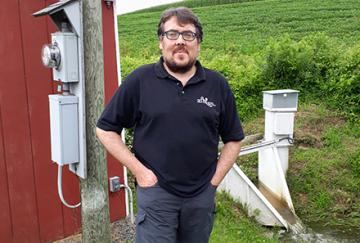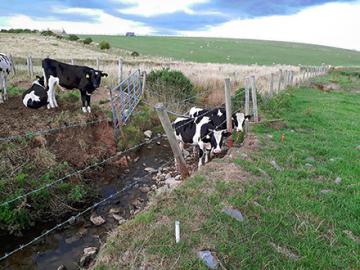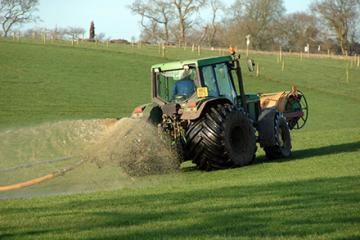International Partnership Keeps Northern Ireland Green, But Not Too Green

Donnacha Doody, Acting Head of the Agri-Food and Biosciences Institute’s (AFBI) Agri-Environment Branch in Belfast, Ireland, visits the USDA-ARS experimental Manhantango Creek Watershed in Central Pennsylvania. (USDA/ARS, D4721-1)
Ireland is so green it’s called the Emerald Isle. That being said, researchers in Northern Ireland are working with the Agricultural Research Service (ARS) to cut back on some of that green.
Excess phosphorus from fertilizer has been leaching from farms into Northern Ireland’s lakes and rivers. A powerful fertilizer on land, phosphorus is equally effective in water, turning waterways green with excess algae and other plant life. When those plants die and decompose, it depletes the water of oxygen – a process called eutrophication – a condition that is harmful to fish and other animal life and could also impact human health.
“In Northern Ireland, 69% of our rivers and 76% of our lakes are impacted by phosphorus, with agriculture contributing 62% of that phosphorus,” said Donnacha Doody, acting head of the Agri-Food and Biosciences Institute’s (AFBI) Agri-Environment Branch in Belfast, Northern Ireland.

Cows in a stream at Agri-Food and Biosciences Institute’s experimental watershed in County Down, Northern Ireland. (Photo by Donnacha Doody, D4720-1)
According to Doody, manure/slurry from livestock is a major source of agricultural phosphorus in Northern Ireland. Slurry is a mix of manure and other organic matter that is thinned with water and, sometimes, aged. If not managed properly, applying manure/slurry as fertilizer could result in phosphorus accumulating in the soil and being washed off by rainfall into lakes and rivers.
The government of Northern Ireland introduced legislation called the Nutrient Action Programme (NAP) to help prevent excess manure from being washed into lakes and rivers. NAP prohibits farmers from spreading manure during winter months and at other times, depending on weather and soil conditions. Doody said that it’s important for both farmers and policy makers to have confidence that their efforts are having a positive impact on water quality, and that’s how he and ARS got involved.
According to Doody, AFBI uses an ARS model called SurPhos (Surface runoff model for Phosphorus) to simulate the amount of phosphorus loss on each day of the year, as determined by rainfall and soil moisture conditions. SurPhos was developed by Peter Vadas, ARS national program leader for land and air management, while working at the Dairy Forage Research Center, in Madison, WI.

Application of slurry at the Agri-Food and Biosciences Institute (AFBI) Hillsborough Farm in Northern Ireland. (Photo courtesy of Cliff Mason/AFBI, D4722-1)
“Results from the SurPhos model demonstrate that NAP is effective at reducing the loss of phosphorus to water in Northern Ireland,” Doody said. “If the ban on spreading slurry during the closed period was lifted and slurry application permitted, the phosphorus export during winter months would be 33% higher.”
Doody’s knowledge of SurPhos came from working with ARS in the United States for 4 months as part of a US-UK Fulbright scholarship. While with ARS, he learned about the phosphorus risk index approach and applying the SurPhos model to Northern Ireland fields. The index was developed at the ARS Pasture Systems and Watershed Management Research unit at University Park, PA.
“This highlights the value of international exchanges between research organizations,” Doody said. “As scientific researchers we spend a long time developing new knowledge, data, and tools and often it is difficult to demonstrate the impact of this work on society. In this case, the report on slurry management was the culmination of long-term data collection in AFBI and development of the SurPhos model in ARS. This long-term investment from both organizations has had an impact on the agri-food industry in Northern Ireland and really demonstrates the value this effort.”

